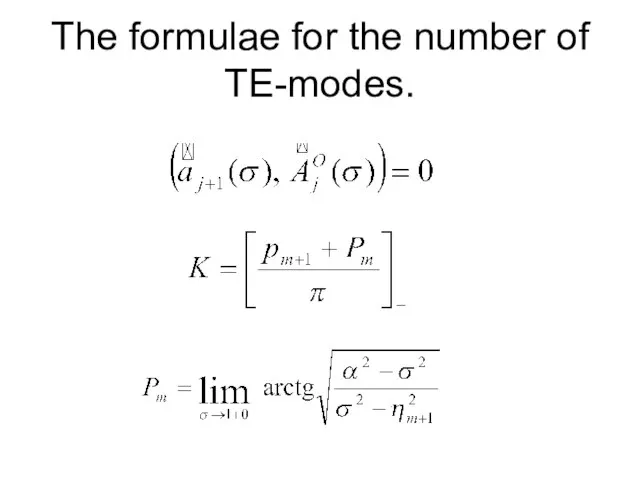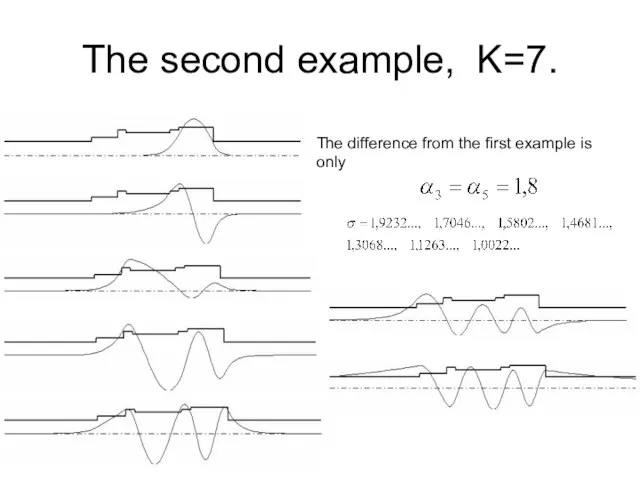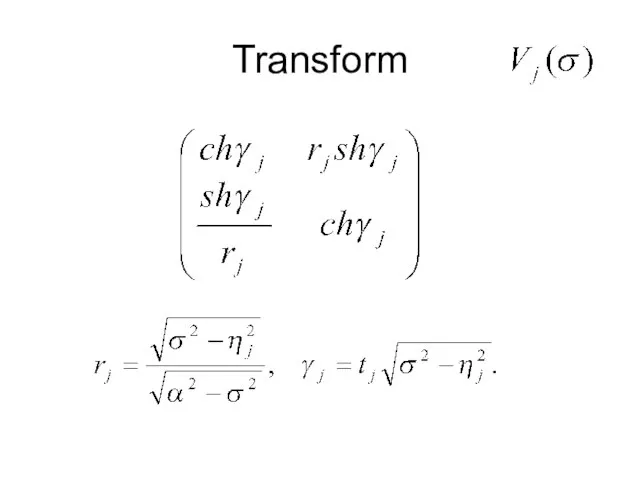Слайд 3For ТЕ-waves propagating along Oz axis this is a boundary-value problem for

the equation
Слайд 5First example. 7 layers. The number of ТЕ-modes: K=6.

Слайд 6Traditional dispersion equations –equations for the eigenvalues of the propagation constant
Type

1 – equation, is obtained by equating to zero of the determinant of homogenius linear system due to boundary conditions.
Type 2 ― equation, obtained by the known method of characteristic matrices
This equations have too many terms if the number of layers is more then 4.
Investigation of waveguides with many layers is now actual.
Слайд 7The properties of the dispersion equations
Th.1. Type 1 equation has roots, coinsiding

with the refraction indexes of the inner layers of the waveguide. This roots may not be the eigenvalues of propagation constant.
Th.2. The set of roots of type 2 equation is exactly the set of the eigenvalues of propagation constant.
We propose a new one form of the dispersion equation. This equation in some known cases have no parasitic roots, and moreover it may be treated geometrically.
Слайд 9Homogenius variables,vectors

Слайд 11Theorem 3. Vectors
rotate counter-clockwise when
is decreasing.
Theorem 4. If
then the directions

of this vectors are converging to the direction of Ox axis.
Слайд 12The multilayer equation in vector form

Слайд 13The formulae for the number of TE-modes.

Слайд 15The second example, K=7.
The difference from the first example is only















 ЭЛЕКТРИЧЕСКИЕ ОТОПИТЕЛЬНЫЕ КОТЛЫ.
ЭЛЕКТРИЧЕСКИЕ ОТОПИТЕЛЬНЫЕ КОТЛЫ. Развитие навыков учебной деятельности дошкольников
Развитие навыков учебной деятельности дошкольников Презентация на тему Причины ВТОРОЙ МИРОВОЙ ВОЙНЫ
Презентация на тему Причины ВТОРОЙ МИРОВОЙ ВОЙНЫ  Just do eat together. Ассортимент
Just do eat together. Ассортимент Смерть вселенной
Смерть вселенной Тема доклада:«Обзор продуктов АПК и примеры решений»
Тема доклада:«Обзор продуктов АПК и примеры решений» Лекция_Заканчивание и ремонт скважин
Лекция_Заканчивание и ремонт скважин Культурные центры Чувашии - центры социального партнерства
Культурные центры Чувашии - центры социального партнерства Материалы для подготовки к ЕГЭпо русскому языку
Материалы для подготовки к ЕГЭпо русскому языку Культура раннего Средневековья
Культура раннего Средневековья Елочные игрушки
Елочные игрушки БАЗЫ ДАННЫХ
БАЗЫ ДАННЫХ Институт бизнеса и делового администрирования РАНХиГС при Президенте РФ
Институт бизнеса и делового администрирования РАНХиГС при Президенте РФ Презентация на тему Борьба с агрессией крестоносцев в XIII-XVI вв
Презентация на тему Борьба с агрессией крестоносцев в XIII-XVI вв  Коррозия металлов
Коррозия металлов Классификации моделей. Классификации моделей...
Классификации моделей. Классификации моделей... Усталостное разрушение бурильной колонны и эрозия
Усталостное разрушение бурильной колонны и эрозия Опыт АБР в поддержке центров электронного общества
Опыт АБР в поддержке центров электронного общества – консультационная компания, специализирующаяся на управленческом и маркетинговом консультировании
– консультационная компания, специализирующаяся на управленческом и маркетинговом консультировании Туристическое объединение Жаворонки. Портфолио
Туристическое объединение Жаворонки. Портфолио Не перевелись богатыри на земле русской
Не перевелись богатыри на земле русской Отрасль Машиностроения
Отрасль Машиностроения Технология трудовой деятельности
Технология трудовой деятельности Страхование имущества
Страхование имущества Функциональная асимметрия мозга
Функциональная асимметрия мозга Электронды портфолиосы
Электронды портфолиосы Great Britain
Great Britain Государственный строй Испании
Государственный строй Испании